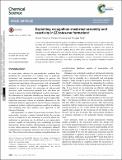Exploiting recognition-mediated assembly and reactivity in [2]rotaxane formation
Date
01/04/2016Metadata
Show full item recordAbstract
A small molecular reaction network exploits recognition-mediated reactive processes in order to drive the assembly and formation of both a self-replicating linear template (thread) and a [2]rotaxane, in which the linear template is encircled by a diamide macrocycle. Complementary recognition sites, placed at strategic positions on the reactive building blocks, drive these assembly and replication processes. Template-instructed experiments show that the thread is capable of efficient self-replication and that no cross-catalytic relationships exist between thread and the [2]rotaxane. The rate of [2]rotaxane formation is insensitive to the addition of preformed template, however, [2]rotaxane formation does show enhanced diastereoselectivity, most likely originating from its recognition- mediated formation through a binary reactive complex.
Citation
Vidonne , A , Kosikova , T & Philp , D 2016 , ' Exploiting recognition-mediated assembly and reactivity in [2]rotaxane formation ' , Chemical Science , vol. 7 , no. 4 , pp. 2592-2603 . https://doi.org/10.1039/C5SC04805B
Publication
Chemical Science
Status
Peer reviewed
ISSN
2041-6520Type
Journal article
Description
The authors thank EaStCHEM (Graduate Studentship to AV), EPSRC (Graduate Studentship to TK, Grant EP/K503162/1) and the University of St Andrews for financial support.Collections
Items in the St Andrews Research Repository are protected by copyright, with all rights reserved, unless otherwise indicated.

